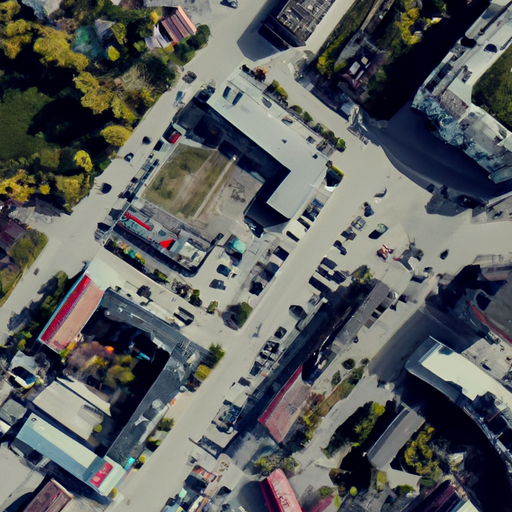Embracing Adaptability: The Key to Success in Modern Complex Design
In today’s rapidly evolving world, the importance of flexibility in modern complex design cannot be overstated. As technology advances and consumer demands shift, designers must be able to adapt and respond to these changes in order to remain competitive and relevant. Embracing adaptability is the key to success in modern complex design, as it allows designers to create innovative solutions that meet the needs of their clients and end-users.
One of the primary reasons why flexibility is so crucial in modern complex design is the ever-changing nature of technology. As new technologies emerge and existing ones evolve, designers must be able to incorporate these advancements into their work. This requires a willingness to learn and adapt, as well as the ability to think critically about how these technologies can be best utilized in a given design. By staying abreast of technological developments and being open to experimentation, designers can create cutting-edge solutions that not only meet the needs of their clients but also push the boundaries of what is possible in their field.
Another factor contributing to the importance of flexibility in modern complex design is the increasing demand for customization and personalization. Today’s consumers expect products and services that cater to their unique needs and preferences, and this trend is only expected to grow in the coming years. Designers must be able to adapt their work to accommodate these individualized requirements, which often involves rethinking traditional design approaches and embracing new methodologies. This may include incorporating modular elements that can be easily reconfigured or updated, or utilizing digital tools that allow for greater customization and adaptability.
In addition to technological advancements and shifting consumer demands, the global nature of today’s economy also plays a significant role in the importance of flexibility in modern complex design. As businesses expand their reach and operate in multiple markets, designers must be able to create solutions that can be easily adapted to different cultural contexts and regulatory environments. This requires not only a deep understanding of the specific needs and preferences of different target audiences but also the ability to think creatively about how to address these challenges in a way that is both effective and efficient.
Moreover, the increasing emphasis on sustainability and environmental responsibility in today’s society further underscores the importance of flexibility in modern complex design. Designers must be able to create solutions that not only meet the functional requirements of their clients but also minimize the environmental impact of their work. This may involve incorporating sustainable materials and practices into their designs, as well as considering the entire lifecycle of a product or building and how it can be designed to minimize waste and energy consumption.
In conclusion, the importance of flexibility in modern complex design cannot be overstated. As technology continues to advance, consumer demands shift, and the global economy becomes increasingly interconnected, designers must be able to adapt and respond to these changes in order to remain competitive and relevant. By embracing adaptability and being open to new ideas and approaches, designers can create innovative solutions that not only meet the needs of their clients and end-users but also contribute to a more sustainable and responsible future. Ultimately, flexibility is the key to success in modern complex design, and those who are able to master this skill will be well-positioned to thrive in this dynamic and ever-evolving field.
Navigating Change: The Role of Flexibility in Contemporary Design Challenges

In today’s rapidly evolving world, the importance of flexibility in modern complex design cannot be overstated. As technology advances and societal needs shift, designers must be able to adapt and respond to these changes in order to create products, systems, and environments that are both functional and aesthetically pleasing. This requires a deep understanding of the principles of flexibility and the ability to apply them effectively in a variety of contexts.
One of the key aspects of flexibility in design is the ability to accommodate change. This can take many forms, from designing products that can be easily updated or modified, to creating spaces that can be reconfigured to serve different purposes over time. For example, consider the rise of modular furniture and architecture, which allows users to rearrange components to suit their changing needs. This type of design not only provides a high level of adaptability but also promotes sustainability by reducing the need for new materials and resources.
Another important aspect of flexibility in design is the ability to respond to the diverse needs of users. In an increasingly globalized world, designers must be able to create products and environments that can be used by people with different cultural backgrounds, abilities, and preferences. This requires a deep understanding of human-centered design principles, as well as the ability to collaborate with a diverse range of stakeholders. By embracing flexibility in this way, designers can create solutions that are not only more inclusive but also more innovative and effective.
In addition to accommodating change and diversity, flexibility in design also involves the ability to navigate complex systems and processes. This is particularly important in the context of large-scale projects, such as urban planning or infrastructure development, where designers must balance a wide range of competing interests and constraints. By adopting a flexible mindset and approach, designers can more effectively navigate these challenges and develop solutions that are both feasible and beneficial for all stakeholders involved.
One of the key enablers of flexibility in design is the use of advanced digital tools and technologies. For example, computer-aided design (CAD) software allows designers to create detailed models and simulations, which can be easily modified and updated as needed. This not only streamlines the design process but also enables designers to explore a wider range of possibilities and make more informed decisions. Similarly, digital fabrication technologies, such as 3D printing and CNC machining, allow for greater customization and adaptability in the production of physical objects.
However, it is important to note that flexibility in design is not just about embracing new technologies or adopting a particular set of principles. Rather, it is a mindset and approach that requires designers to be open to change, willing to collaborate, and able to think critically and creatively about the challenges they face. This may involve questioning established norms and practices, as well as seeking out new perspectives and ideas from a diverse range of sources.
In conclusion, the importance of flexibility in modern complex design cannot be overstated. As the world continues to change at an unprecedented pace, designers must be able to adapt and respond to these shifts in order to create solutions that are both functional and aesthetically pleasing. By embracing the principles of flexibility and adopting a flexible mindset and approach, designers can not only navigate the challenges of contemporary design but also contribute to a more sustainable, inclusive, and innovative future.
Balancing Form and Function: The Crucial Integration of Flexibility in Modern Design Solutions
In the ever-evolving world of design, the importance of flexibility cannot be overstated. As the needs and preferences of consumers change, so too must the designs that cater to them. This is particularly true in the realm of complex design, where the integration of various elements and systems requires a delicate balance between form and function. By incorporating flexibility into modern design solutions, designers can ensure that their creations not only meet the demands of today but can also adapt to the challenges of tomorrow.
One of the key aspects of flexibility in design is the ability to accommodate change. This can be achieved through the use of modular components, which can be easily reconfigured or replaced as needed. For example, in the realm of architecture, modular building systems allow for the construction of structures that can be easily expanded or reconfigured to meet changing needs. This not only saves time and resources but also ensures that the building remains functional and relevant throughout its lifespan.
Similarly, in product design, the use of modular components allows for the creation of products that can be easily upgraded or customized to meet the specific needs of individual users. This not only enhances the overall user experience but also extends the lifespan of the product, reducing waste and promoting sustainability.
Another important aspect of flexibility in design is the ability to adapt to new technologies and advancements. As technology continues to evolve at a rapid pace, designers must be prepared to integrate these advancements into their creations. This can be achieved through the use of open standards and platforms, which allow for the seamless integration of new technologies and systems.
For example, in the realm of software design, the use of open-source platforms allows developers to easily incorporate new features and functionalities into their applications. This not only ensures that the software remains up-to-date and relevant but also promotes collaboration and innovation within the design community.
In addition to accommodating change and embracing new technologies, flexibility in design also involves the ability to cater to a diverse range of users and needs. This can be achieved through the use of inclusive design principles, which seek to create products and environments that are accessible and usable by as many people as possible.
For example, in the realm of urban planning, the incorporation of inclusive design principles can help to create public spaces that are accessible to individuals with varying levels of mobility, ensuring that all members of the community can enjoy and benefit from these spaces. Similarly, in product design, the use of inclusive design principles can help to create products that are usable by individuals with varying levels of ability, ensuring that these products are truly accessible to all.
In conclusion, the integration of flexibility in modern design solutions is crucial for ensuring that designs remain relevant and functional in the face of changing needs and technologies. By incorporating modular components, embracing open standards and platforms, and adhering to inclusive design principles, designers can create products and environments that are not only aesthetically pleasing but also adaptable and accessible to a diverse range of users.
As the world continues to evolve and change, so too must the designs that inhabit it. By prioritizing flexibility in design, we can ensure that our creations are not only beautiful but also functional, sustainable, and inclusive, meeting the demands of today while also preparing for the challenges of tomorrow.
Q&A
Question 1: Why is flexibility important in modern complex design?
Answer: Flexibility is important in modern complex design because it allows for adaptability to changing requirements, technologies, and user needs. It enables designers to create solutions that can evolve over time, ensuring the design remains relevant, functional, and efficient.
Question 2: How does flexibility contribute to the sustainability of a design?
Answer: Flexibility contributes to the sustainability of a design by allowing it to adapt to changing conditions and requirements without the need for complete redesign or replacement. This reduces waste, conserves resources, and minimizes the environmental impact of the design throughout its lifecycle.
Question 3: What are some strategies for incorporating flexibility into complex design projects?
Answer: Some strategies for incorporating flexibility into complex design projects include modular design, which allows for easy modification and reconfiguration; designing for scalability, so that the design can grow or shrink as needed; using open standards and interoperable components to ensure compatibility with future technologies; and incorporating user feedback and iterative design processes to continuously refine and improve the design.
Conclusion
In conclusion, the importance of flexibility in modern complex design cannot be overstated. As the world continues to evolve and technology advances, designers must adapt to changing needs, requirements, and constraints. Flexibility allows for more efficient use of resources, better adaptability to unforeseen challenges, and the ability to create innovative solutions that cater to diverse user needs. Ultimately, incorporating flexibility in design processes leads to more resilient, sustainable, and successful outcomes in the ever-changing landscape of modern design.


